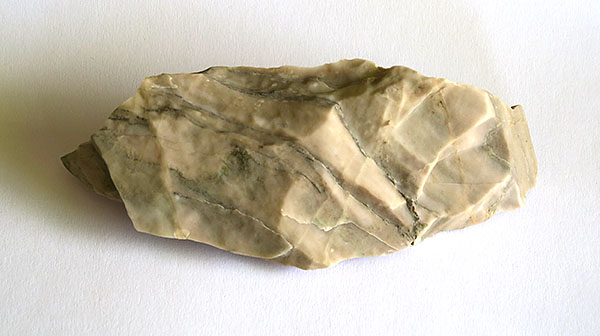Geology on site
Ross Island is a claw-shaped peninsula in Killarney National Park, County Kerry. In addition to the copper mine on Ross Iceland there are still other interesting rocks: cherts in the limestone layers
The Carboniferous rocks are predominantly limestone, including both massive unbedded reef limestone formations and bedded calcarenites. There are also relatively thin but significant chert (i.e. siliceous) formations, comprising layered and nodular black cherts among finely stratified limestones and calcareous mudstones. The Carboniferous formations outcrop extensively along and near the Muckross Lake and Lough Leane shores, the outcrops including expanses of irregular limestone pavement with numerous vertical fissures.

Figure: Layering of limestone
Limestone layers
Notice the layering of the limestone in the reef alongside the path. This limestone was laid down in the Carboniferous Period 295-345 million years ago when lreland was covered by a shallow warm sea. Limestone is composed principally of calcium carbonate which is derived from a number of sources. Where the sea contains more calcium carbonate than can be dissolved, the surplus is deposited on the sea floor. Fragments of coral, sea lily stems and shells of animals, all of which were composed of calcium carbonate, accumulated on the ocean floor and these became cemented together by the deposition of more calcium carbonate. Fossilized coral reefs are another source of the limestone rock.
Chert
The pale smooth limestone alternates with the darker, chert layers, which are more resistant to erosion. Chert is a form of silica (silicon dioxide). lts presence reflects changes in chemical conditions as sea levels fluctuated over the millennia and the silica was probably deposited as the run off from river estuaries into a shallow sea. The name for these different layers is "bedding"; and an individual layer is termed a "bed".

Figure: Chert
Chert versus flint
One wonders, is chert a flint?
Strictly speaking, the term "flint" is reserved for varieties of chert which occur in chalk and marly limestone formations. Among non-geologists, the distinction between "flint" and "chert" is often one of quality - chert being lower quality than flint.
Distinction between chert and flint:
- Flint is a compact microcrystalline quartz. It is found inc halk or marly limestone formations and is formed by a replacement of calcium carbonate withs ilica. It is commonly found as nodules.
- "Common chert" is a variety of chert which forms in limestone formations by replacement of calcium carbonate with silica. This is the most abundantly found variety of chert.
Source: Killarney National Park, Wikipedia
Images: Own (Copyright)
* * * * * * * * * * * * * * * * * * * * * * * * * * * * * * * * * * * * * * * * * * * * * * * * * * * * * * * * * * * * * * *
To log the EarthCache, answer the following questions:
There is no information board on site. All questions can be answered with the information of the listing, your observations on site and some thinking.
Reference: In case of a flood the questions can be answered worse or not at all!
1. What is the angular degree of the oblique layers? Can you justify how these inclined layers emerge?
2. What do you think, why the layers in between torn?
3. Search and find a chert on the layers or on the ground? Describe the surface condition!
4. Take a photo of yourself, a personal object or the GPS with readable coordinate against the background of the location as proof of your attendance. (According to the Earthcache Guidelines, the requirement for photographic evidence has been permitted again since June 2019.)
Send your answers via contact from my profile or chert@ahsoka.de and you may log instantly. At inconsistencies I will contact you.
If you like my Earthcache or walk, I look forward to a favorite point :-)
Hope you enjoy !
* * * * * * * * * * * * * * * * * * * * * * * * * * * * * * * * * * * * * * * * * * * * * * * * * * * * * * * * * * * * * * *